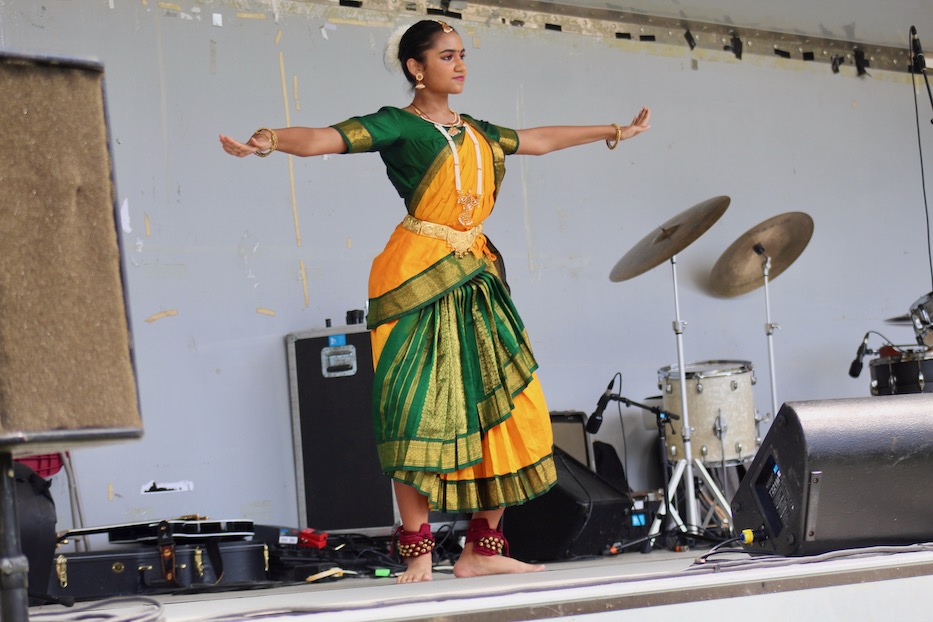
Dance | Downtown | International Festival of Arts & Ideas | Storytelling | Arts & Culture | New Haven Green
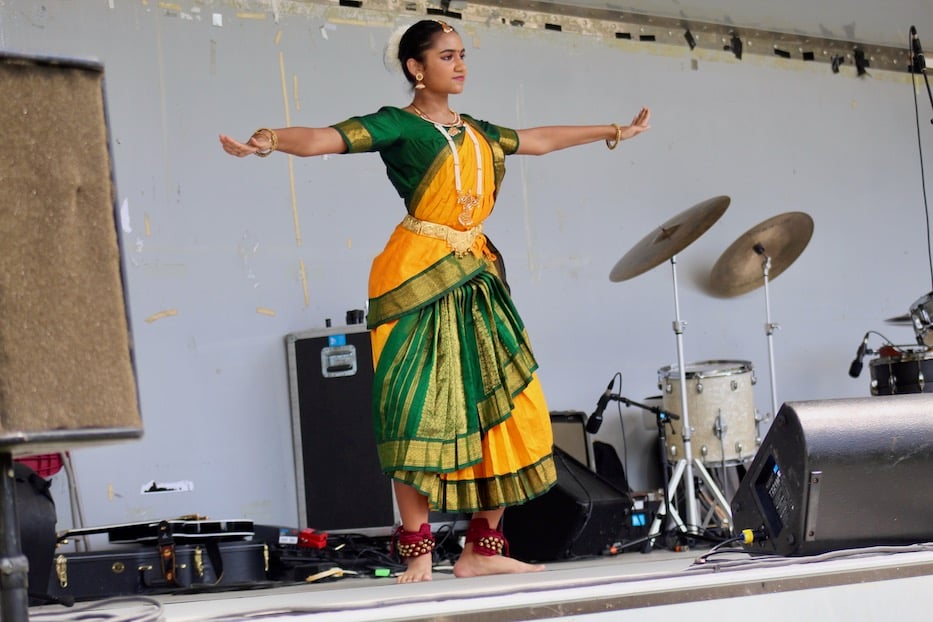
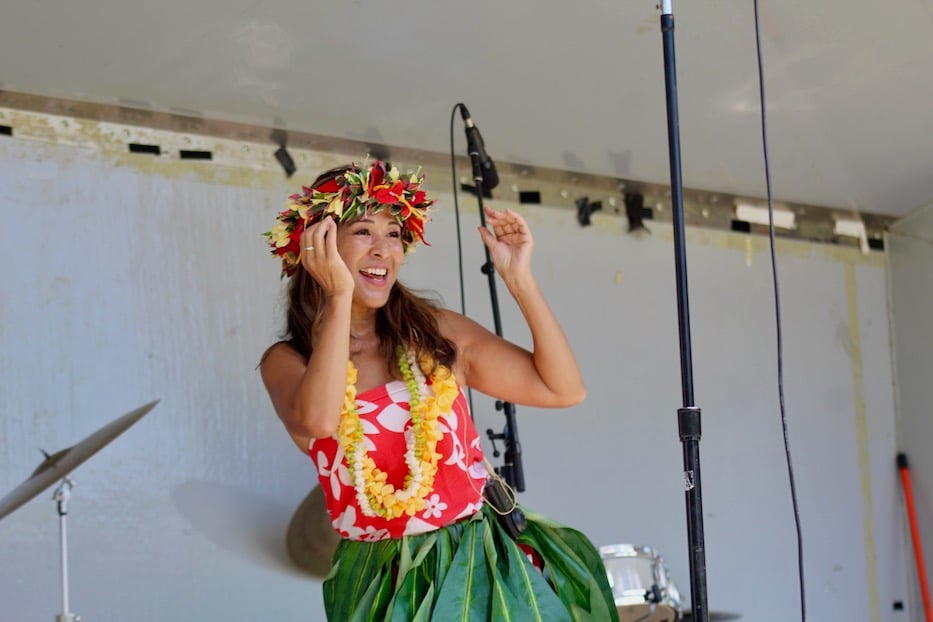
Rania Das and Tiare Kahana on the New Haven Green Thursday. Lucy Gellman Photos.
Rania Das moved slowly, carefully to the music. Her arms extended, tilting towards the stage as her torso lifted skyward. She shifted her head sharply to the left, and then to the right, eyes full of laughter. She dropped into a squat, arms cutting through the air in a diagonal. In each movement she told a story of the trickster Lord Krishna, whose charm and beauty often excused his prankster side.
Thursday afternoon, Das brought Bharatanatyam to the New Haven Green as part of the inaugural Rhythm Exchange, an initiative of the International Festival of Arts & Ideas and Proprietors of the New Haven Green to bring music, dance, and immersive performance to the heart of the city. From now through early November, it is scheduled to run from noon to 1:30 p.m. every other week. It concludes with a Day of the Dead ceremony with Unidad Latina en Acción on Nov. 3. A full schedule is available here.
“It represents the diversity that exists in New Haven,” said Shelley Quiala, executive director of the festival. “You’ll see as it goes—some [events] are immersive, and some artists really juxtapose each other.”
It marks the latest effort from the proprietors to activate the Green with arts and culture. Thursday featured the Indian classical dance form known as Bharatanatyam, Hula dance and storytelling, and jammy new compositions from musicians Cliff Schloss and Avery Collins. Quiala said that the series is part of her hope to keep festival programming going year-round. She worked closely with Kica Matos, one of the proprietors, to bring it into being.
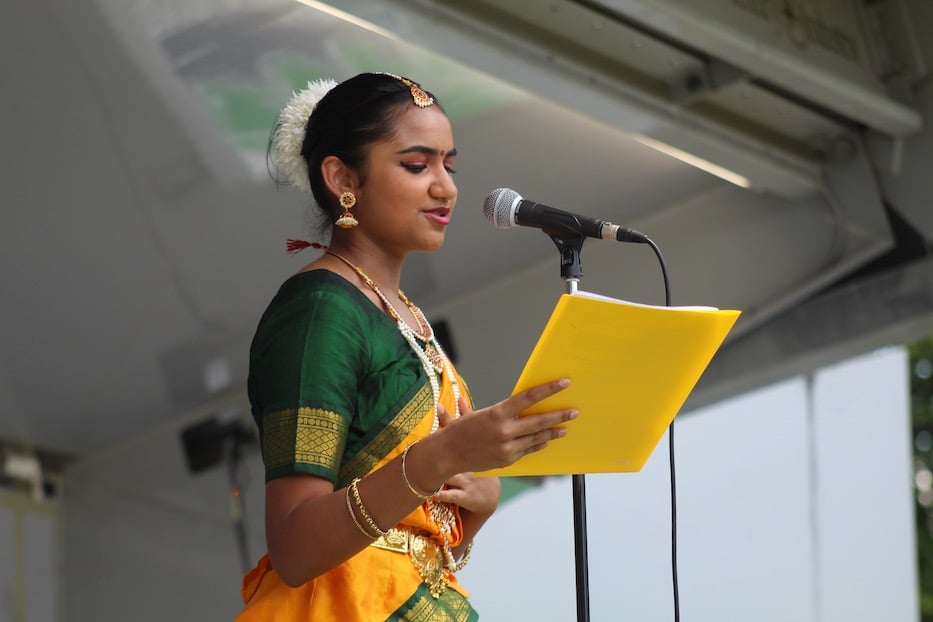
Just a little after 12 p.m. Thursday, 14-year-old Das took the stage, layers of green and gold silk glowing in the midday sun. On her ankles, dozens of tiny, bronze-colored bells called ghungroos waited for the first suggestion of movement. She took a beat and approached the mic, looking out at a growing knot of people as attendees trickled in. As she spoke, it seemed that someone much older than a high school freshman was sharing knowledge.
“I think one reason it really called to me was because it was something that really kept me close to my roots,” she said in an interview with the Arts Paper after the performance. “Bharatanatyam doesn’t come from the state where my parents are from in India [they are from Calcutta, in West Bengal], but it’s a very well-loved art form all over the country.”
As music began to play over the speakers, Das moved into an Alarippu—the first dance that Bharatanatyam dancers often do, and a way to introduce New Haveners to the centuries-old steps that build the form. Sitar, tabla and tambura sailed over the grass, weaving through her bent knees and outstretched arms. Her eyes went wide, filled with a curiosity that gave way to a gleaming, prankish sort of delight.
It was the first of three offerings that she brought into the space. In between the Alarippu and second number, the Shabdam, Das explained that she was telling a story through dance and movement. She told attendees that the Shabdam honored Lord Krishna, the god of protection and compassion. And, she added with a smile, a total trickster.
Each movement—from her head to her wrists and hands to her toes—was a nod to Lord Krishna’s love of a good joke. In the first part of the dance, a group of people ease themselves into a pool of water, removing their saris as they bathe. As they are in the water, Krishna steals their clothes, “and then he’s gonna watch their reactions from the treetops,” she said. Then he spies pots of cream—a delicacy “Lord Krishna simply cannot resist.” He pierces the pots with his fingertips and devours the sweet, cool treat inside.
She stepped back from the mic, her hands still on her hips as music wound from a speaker through the hot air, surrounding her in sound. As vocals came in, she lifted her hands, her head shifting to one side, then to the other, then back again. Her eyes swiveled to her front, then back to the edges of the stage, glowing with mischief. Her elbows still bent, she extended her arms. She stepped forward, feet hitting the stage in time with the music, and then just as quickly sank into a crouch. The music kept her moving.
“I hope you enjoyed this art, because I know that I enjoyed sharing my art and my culture with the New Haven community,” she said before her third and final dance, the Vasantha Jathiswaram.
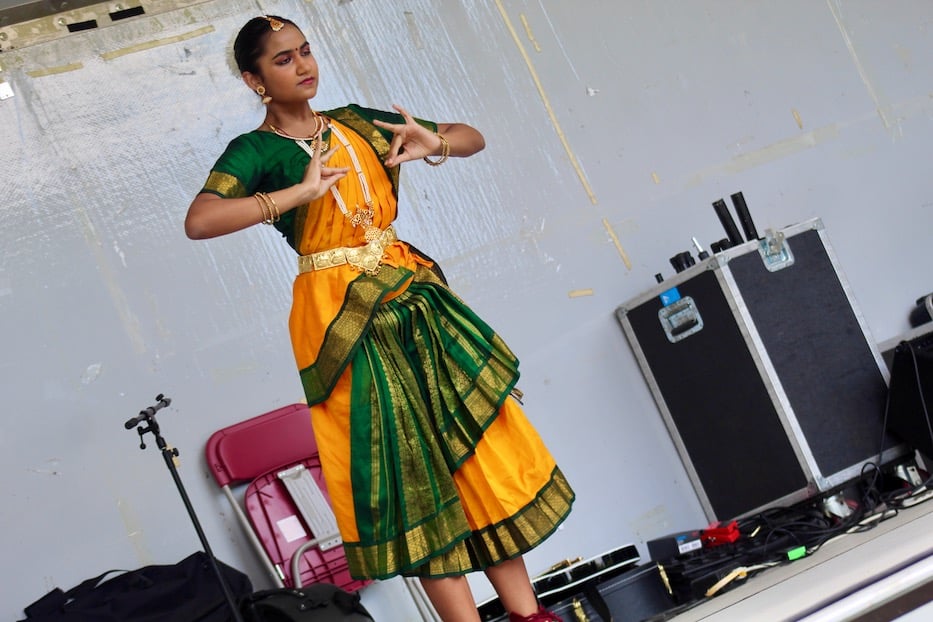
Jathiswarams, she continued, “are a display of arivus, or steps, and sutras, or hand gestures, and it’s performed to a variation of swaras,” passages that are part of a melody and rhythm. She planned to dance to Vasantha, she added—which belongs to the Carnatic music tradition of South India. Within moments, she was again in motion on the stage, bringing hundreds of years of tradition to the Green.
Das, who grew up in New Haven and is a rising freshman at the Hopkins School, started Bharatanatyam five years ago as a way to keep a tradition alive. Her mom, Manmita Dutta, grew up in Calcutta, where she attended an all-girls school that taught classical dance as part of the curriculum. When Das was just a kid, Dutta expressed a wish for her daughter “to learn an art form like we had when we were growing up.” It led her to Das’ longtime teacher, the Wilton-based dance educator Jaynti Seshan.
Each weekend, Das and her parents pile into the car and drive from New Haven to Wilton for lessons. It has made her think about the similarities between Carnatic music, Western music, and popular music in between (she is a fan of K-Pop and likes learning its dances, she said with a laugh). When she’s performing, she said, she counts her movements methodically, as if a metronome is working overtime in the corners of her mind. In recent years, she has become interested in the evolution of Bharatanatyam from a classical tradition to a form of activism and protest.
It’s also become a bridge to her parents’ home country. When she dances in New Haven—Thursday marked her first solo performance—she knows that she’s a cultural ambassador to a form many New Haveners have never seen or heard of before. When she visits family in India, she said, “I feel like I’ve found something new to talk about,” particularly with the elders in her life.
“I think in that way, it’s gotten me closer not only to my roots, but also to my family,” she said.
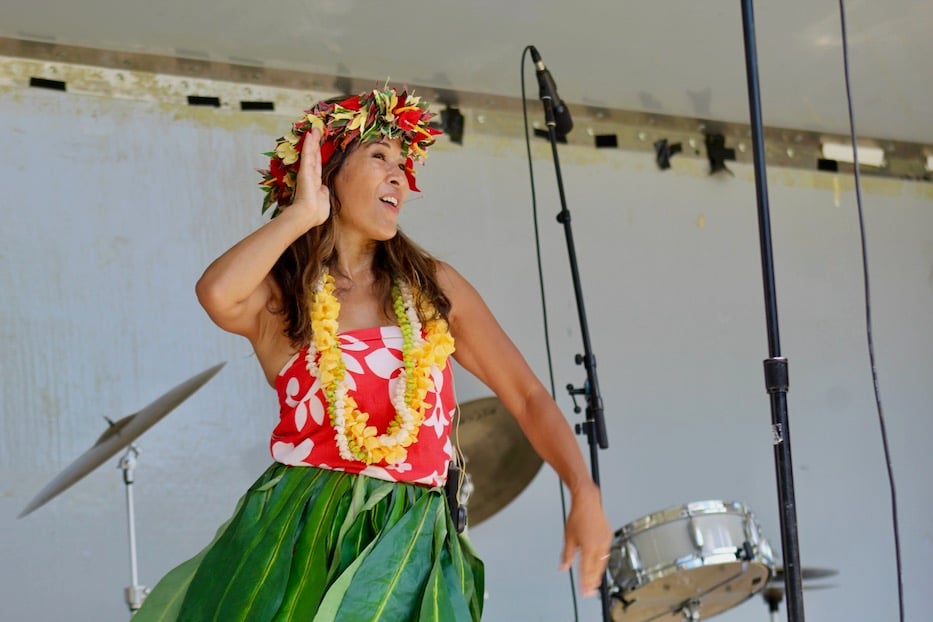
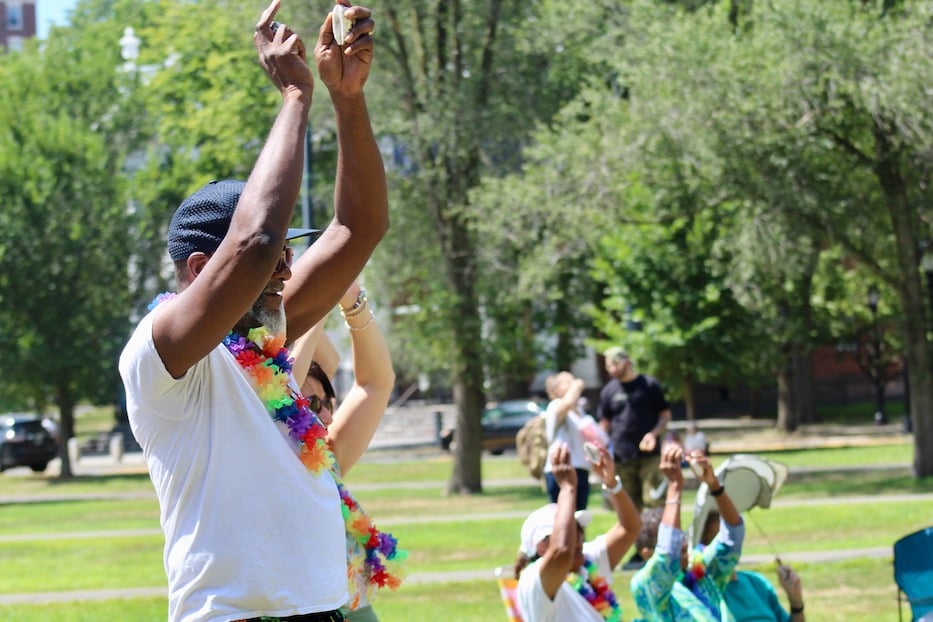
Tiare Kahana: "People understand that hula is a sacred art, that it has sacred roots.”
Back on stage, Tiare Kahana swayed from side to side, directing attendees as they lifted shells from a basket placed on the grass, and then moved in step with her. To rising instrumentals, she extended her arms, and in them held an entire history of native Hawiian history and culture.
Born and raised in Los Angeles, Kahana grew up learning about Hawaii from her parents, who lived there before their move to the West Coast. As a kid, she said, she was surrounded by a Hawaiian community that is bigger and more accessible than Connecticut’s—although “we find each other” in the Nutmeg State. She made her way to Connecticut in 1987, and never left.
A teaching artist for Arts For Learning Connecticut, Kahana said she’s used to bringing her work to both schools and senior centers. In schools, she encourages students to call her “auntie,” as a reminder that they are part of a large human family. At nursing homes, she sees how movement and music sometimes stirs up memories that have been dormant for decades. She sees an easy way to bust through harmful and enduring stereotypes of Hawaii and Indigenous Hawaiians.
“The main thing is we are spreading the aloha spirit,” she said. “When you’re raising the energy of people, when you’re dancing, you’re reminding them that we’re family … that we need to take care of each other. People understand that hula is a sacred art, that it has sacred roots.”
She also uses her craft to “encourage people to look into where they come from,” she added.
As she stepped off of the stage and back onto the warm grass, Schloss and Collins took her place. It was a little past 1 p.m. and seemed, for just a while longer, that maybe the jam could go all afternoon long.
Rhythm Exchange is an initiative of the International Festival of Arts & Ideas and Proprietors of the New Haven Green to bring music, dance, and immersive performance to the heart of the city. From now through early November, it is scheduled to run from noon to 1:30 p.m. every other Thursday. The next session, on Sept. 1, features jazz and gospel. A full schedule is available here.

